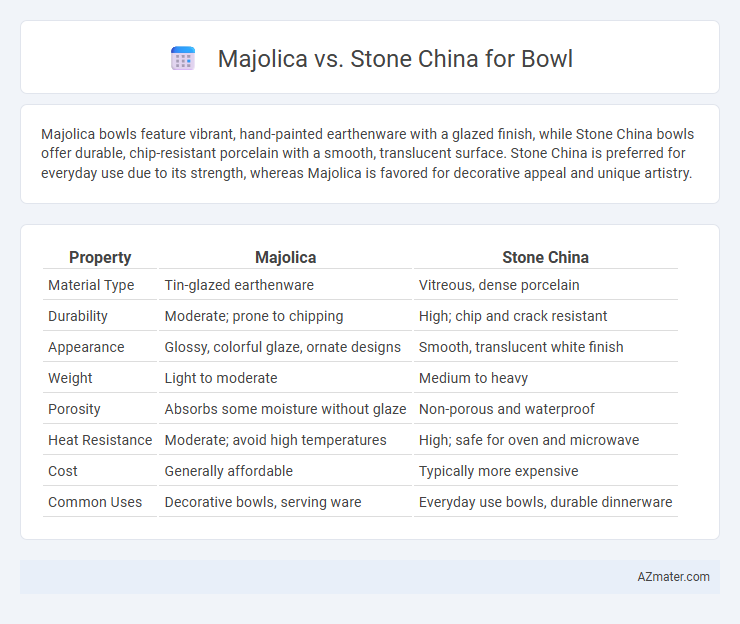Majolica bowls feature vibrant, hand-painted earthenware with a glazed finish, while Stone China bowls offer durable, chip-resistant porcelain with a smooth, translucent surface. Stone China is preferred for everyday use due to its strength, whereas Majolica is favored for decorative appeal and unique artistry.
Table of Comparison
| Property | Majolica | Stone China |
|---|---|---|
| Material Type | Tin-glazed earthenware | Vitreous, dense porcelain |
| Durability | Moderate; prone to chipping | High; chip and crack resistant |
| Appearance | Glossy, colorful glaze, ornate designs | Smooth, translucent white finish |
| Weight | Light to moderate | Medium to heavy |
| Porosity | Absorbs some moisture without glaze | Non-porous and waterproof |
| Heat Resistance | Moderate; avoid high temperatures | High; safe for oven and microwave |
| Cost | Generally affordable | Typically more expensive |
| Common Uses | Decorative bowls, serving ware | Everyday use bowls, durable dinnerware |
Introduction to Majolica and Stone China
Majolica is a type of earthenware pottery distinguished by its vibrant, tin-glazed surface that creates a glossy, colorful finish, often featuring intricate hand-painted designs. Stone China, also known as stoneware porcelain, is a durable, vitrified ceramic offering a smooth, non-porous surface with a more subdued, elegant appearance due to its higher firing temperature and denser composition. Both materials are popular for bowls, with Majolica prized for artistic expression and Stone China valued for its strength and practicality.
Origins and Historical Background
Majolica bowls originated during the Italian Renaissance in the 15th century, renowned for their vibrant tin-glazed earthenware decorated with intricate, colorful designs. Stone China, developed in the late 18th century in Europe, is a durable, vitreous form of porcelain made primarily from feldspar, quartz, and kaolin clay, prized for its strength and translucent quality. Both ceramics reflect distinct cultural heritages--Majolica embodies artistic expression rooted in Mediterranean craftsmanship, while Stone China represents advancements in industrial ceramic manufacturing.
Material Composition and Manufacturing Processes
Majolica bowls are crafted from earthenware clay coated with a tin glaze that creates a bright, opaque white surface ideal for detailed hand-painted designs, while stone china bowls use a refined, vitrified porcelain clay known as stoneware, which is durable and chip-resistant. Majolica involves a two-stage firing process where the tin glaze is applied before the decoration and then fired again, resulting in a glossy, colorful finish; stone china is formed from feldspar, kaolin, and quartz and undergoes a single high-temperature firing, producing a dense, non-porous body. The distinct material compositions and firing techniques define Majolica's vibrant, artisanal appearance versus stone china's sleek, strong, and translucent qualities.
Distinctive Characteristics and Appearance
Majolica bowls feature vibrant, hand-painted glazes with intricate, colorful designs that create a glossy, artistic finish. Stone China bowls exhibit a more muted, matte or semi-gloss surface with subtle patterns, emphasizing durability and a heavier, dense ceramic feel. The distinctive characteristic of Majolica lies in its decorative, earthenware appeal, while Stone China is prized for its dense, stoneware composition and understated elegance.
Durability and Everyday Usability
Majolica bowls feature a colorful, glazed surface that can be more prone to chipping and cracking with heavy daily use, making them less durable for high-traffic kitchens. Stone China bowls offer superior toughness due to their dense, vitrified composition, resisting chips and scratches while withstanding frequent microwave and dishwasher cycles. For everyday usability, Stone China is generally preferred because it combines durability with ease of maintenance, whereas Majolica is often reserved for decorative or occasional use.
Design Styles and Artistic Appeal
Majolica bowls feature vibrant, hand-painted glazes with intricate, often nature-inspired motifs that emphasize rustic charm and a lively aesthetic. Stone china bowls present a more refined, minimalist design with smooth finishes and subtle patterns, showcasing elegance suited for modern or traditional table settings. Both materials appeal to distinct artistic tastes, with Majolica highlighting colorful folk art and stone china emphasizing understated sophistication.
Price Range and Collectibility
Majolica bowls typically fall within a moderate price range, often between $30 to $150 depending on age, maker, and condition, making them accessible for most collectors. Stone china bowls, known for their durability and fine finish, generally command higher prices, ranging from $50 up to several hundred dollars, especially for vintage or limited-edition pieces. Collectibility of Majolica is driven by its vibrant glazes and historical appeal, while stone china is prized for its classic elegance and widespread use in both everyday and formal dining collections.
Maintenance and Care Requirements
Majolica bowls require gentle hand washing with mild detergents to prevent chipping and preserve their vibrant glaze, avoiding abrasive scrubbers and dishwasher use. Stone china bowls are more durable and dishwasher safe, offering easier maintenance while resisting scratches and stains better than majolica. Proper storage in a dry place is essential for both materials to prevent moisture damage and maintain their longevity.
Pros and Cons of Majolica Bowls
Majolica bowls offer vibrant, hand-painted designs that make each piece unique, adding artistic value and charm to any table setting. They are porous and more prone to chipping compared to stone china, requiring gentle handling and careful cleaning. Their appeal lies in decorative use rather than heavy everyday function, whereas stone china provides greater durability and resistance to stains and breaks.
Pros and Cons of Stone China Bowls
Stone china bowls offer exceptional durability and chip resistance, making them ideal for everyday use in both home and commercial settings. Their non-porous surface ensures stain and odor resistance, enhancing hygiene and ease of cleaning compared to Majolica, which is more porous and prone to crazing. However, stone china lacks the vibrant, intricate glaze finish of Majolica, which is prized for decorative appeal but can be more fragile and susceptible to chipping.

Infographic: Majolica vs Stone China for Bowl
 azmater.com
azmater.com